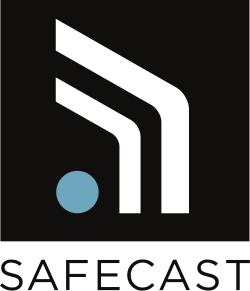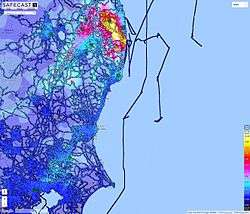Safecast (organization)
 | |
| Founded | 2011 |
|---|---|
| Founder | Sean Bonner, Joi Ito and Pieter Franken |
| Focus | open citizen science |
| Location |
|
| Method | volunteer based data collecting, open hardware development, online data network |
Key people | Sean Bonner, Joi Ito, Pieter Franken |
| Website | safecast.org |
Safecast is an international, volunteer-centered organization devoted to open citizen science for the environment. Safecast was established shortly after the Fukushima Daiichi nuclear disaster in Japan, following the Tōhoku earthquake on 11 March 2011 and manages a global open data network for ionizing radiation monitoring.
The Safecast team, with help of International Medcom, Tokyo Hackerspace and other volunteers, has designed various devices for radiation mapping. These include the bGeigie and bGeigie Nano for mobile applications (carborne and walking measurements) as well as fixed stations called Pointcast.
All data are collected via the Safecast API and are presented on the publicly available interactive Safecast Tile Map.
bGeigie Nano
Safecast bGeigie Nano is a portable radiation detector equipped with a Geiger-Mueller tube type detector, built-in GPS and logging to microSD card.
 bGeigie Nano with closed case
bGeigie Nano with closed case Safecast bGeigie Nano opened
Safecast bGeigie Nano opened

The bGeigie Nano is available as a kit, so the user needs to learn how to solder in order to build it from the supplied parts. The kit can be purchased from the Kithub product page. The device was developed in collaboration with International Medcom Inc. and shares some parts with their Inspector Alert™ detector. According to the Safecast Github page "bGeigie Nano is a lighter version of the bGeigie Mini using an Arduino Fio, a GpsBee, an OpenLog and an Inspector Alert geiger counter. The aim is to make everything fit in a Pelican Micro Case 1040". The final version of the bGeigie is placed inside the smaller Pelican Micro Case 1010. It features the LND 7317 pancake Geiger-Mueller tube type detector, a GPS receiver and is expandable with a Bluetooth module. The mode switch offers choice between geotagged radiation logging (data saved to microSD card) and measuring without GPS - showing also Bq/m2 (Cs137) values. Inside the case the unit is calibrated for gamma radiation. The main unit taken out of its case will additionally do α- and β-detection for careful use as a surface contamination spot meter.
According to the KitHub page [1] Safecast devices are also used by the following institutions:
- International Atomic Energy Agency (IAEA)
- Institute for Radiological Protection and Nuclear Safety / Institut de radioprotection et de sûreté nucléaire (IRSN), France
- Natural Resources Defense Council (NRDC), United States
- Czech National Radiation Protection Institute / Státní ústav radiační ochrany (SÚRO), Czech Republic
Slovenian NGO IRNAS - Institute for development of advanced applied systems Rače / Inštitut za razvoj naprednih aplikativnih sistemov Rače performs monitoring in Slovenia [2] with their one bGeigie
References
- ↑ https://kithub.cc/safecast-researchers/ - KitHub - Agencies Using Safecast Devices
- ↑ http://irnas.eu/other%20projects/2015/06/07/safecast-slovenia - Radiation monitoring of Slovenia with Safecast
External links
- Official website
- bGeigie Nano radiation detector homepage
- Safecast Device Discussions and Support - Google Groups
- Safecast open software and hardware repository
- Brown, Azby; Baumont Genevieve; Kuča, Petr; Helebrant, Jan - Citizen-based radiation measurement in Europe: Supporting informed decisions regarding radiation exposure for emergencies as well as in daily life. RICOMET2016 Conference poster. Available online as PDF.
- Brown, Azby; Franken, Pieter; Bonner, Sean; Dolezal, Nick; Moross, Joe - Safecast: successful citizen-science for radiation measurement and communication after Fukushima - Published 6 June 2016 • © 2016 IOP Publishing Ltd Journal of Radiological Protection, Volume 36, Number 2, available online.